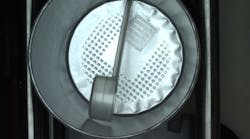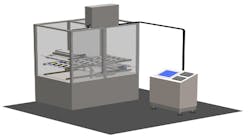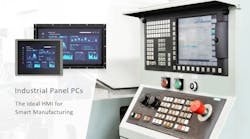Automated production features total traceability
Flexibility, quality, and reaction time define success in the production of electronics boards on an automated production line. In Germany at the Burbach location of EbV Elektronik (Munich, Germany; www.ebv.com), where all manual process steps are excluded from the production line, a network of vision sensors from Cognex (Natick, MA, USA; www.cognex.com) helps achieve a smooth and efficient process chain.
In EbV Elektronikbau- und Vertriebs-GmbH’s automated production Plant II in Burbach, production of electronics boards is organized and optimized so that small quantities of product can be handled with flexibility and high throughput. Immediately after being laser marked, the Data Matrix codes are checked by vision sensors. Results are then stored and include all the fabrication data collected up to the time the product is delivered to the customer. Rommel (Ehingen, Germany; www.rommel-gmbh.de) integrated the In-Sight line of vision sensors throughout the complete project.
Forty-two In-Sight 1010 vision sensors for code reading have been integrated into a network in the production line. If updates of the respective batches in PCB production are necessary, they are programmed into the sensors using Cognex’s spreadsheet interface.
Robotic harvester picks food in remote locations
Ohio Agricultural Research and Development Center (Wooster, OH, USA; www.ag.ohio-state.edu) researchers, working with a grant from NASA (Washington, DC, USA; www.nasa.gov) are developing a vision-guided robot that can help with production and harvesting of crops in space. The robotic manipulator, provided by Motoman (West Carrollton, OH, USA; www.motoman.com), can locate and grasp tomatoes with four fingers, then apply a pulling, bending, or torsion movement to detach it from the stalk.
Peter Ling and his team at the center’s department of food, agricultural, and biological engineering developed image-processing algorithms to determine sizes and locations of mature tomatoes, including ones that are partially obstructed by leaves or branches. The robotic harvester has been tested in the laboratory and in commercial greenhouses with success rates of 95% for fruit sensing and 85% for picking. Ling says they are looking to develop the technology commercially for apples and oranges as well, and he has seen interest from Arizona greenhouse tomato growers and the Florida citrus industry.
Fast sensor sorts by color
Researchers at Siemens R&D (Munich, Germany; www.siemens.com) have developed a fast 640 × 480-pixel CMOS sensor that obtains information solely from the color composition of an image, making it possible to distinguish quickly between complex images. The sensor reduces the data volumes to be compared to less than 4 kbytes (down from 2 to 3 Mbytes) by using algorithms stored in an image-processing unit. The sensor system creates a data list containing only the color spectrum and brightness level after recording each image. These data can be depicted as a point cloud, which can be compared to a reference image point cloud.
The researchers plan to use the sensor to check product labels on conveyor belts, where it will be able to recognize the color composition of a label regardless of how the labels are arranged. For example, the system could also check bottle caps on the basis of color to ensure correct packing in cartons. The system differentiates between “correct” and “incorrect” images within 30 ms, and researchers say recognition time should be reduced to 10 ms by combining the sensor and image-processing unit onto one chip.
Wireless Ethernet IR cameras monitor gasification units
A two-vessel Chevron-Texaco-designed gas-separation system in Texas is being monitored by a wireless radiometric camera network developed by Texas Infrared (Hancock, MI, USA; www.texasir.com) using 14 MikroScan 7302 IR cameras with built-in wireless Ethernet boards and MikroSpec R/T software from Mikron Infrared (Hancock, MI, USA; www.mikroninfrared.com). The monitoring system provides real-time tracking with computer-generated alarms against burn-throughs and temperature excursions and stores trend data for analysis and process improvement.
The gasification units operate at about 1100 psi, with internal firing at approximately 2600oF and exterior shell temperatures ranging from 200oF to 500oF. Six to eight inches of insulation protects the 1-in.-thick carbon-steel unit shells. The wireless system replaces a 12-in.2 thermocouple grid monitoring system that had been fixed to the shells. Failures of thermocouples or problems with the fiberoptic connecting cables had created gaps in coverage and hazardous maintenance tasks. Now, the MikroSpec R/T software allows each IR camera to track up to 32 regions of interest, each defined by any of 10 shapes, including freehand. Specific temperatures can be monitored at up to 448 locations covering more than 80% of the total surface of the two 60-ft-high units.
Software monitors plant floor
I-Beam Capture Server software from Real Time Iron (Schaumburg, IL, USA; www.realtimeiron.com) provides plant information on images and data using analog or FireWire cameras, barcode readers, programmable controllers, and other serial devices. “Integrating plant-floor images and data with this software allows developers to manage risk, optimize production, and visualize processes,” says Jim Nesbitt, director of sales.
The software helps bridge the divide that has traditionally prevented plant-floor images from being combined with plant-floor data. By using an internal Web-report browser, images and data can be accessed from any workstation connected to a network. Systems integrators can select and view reports and status.



